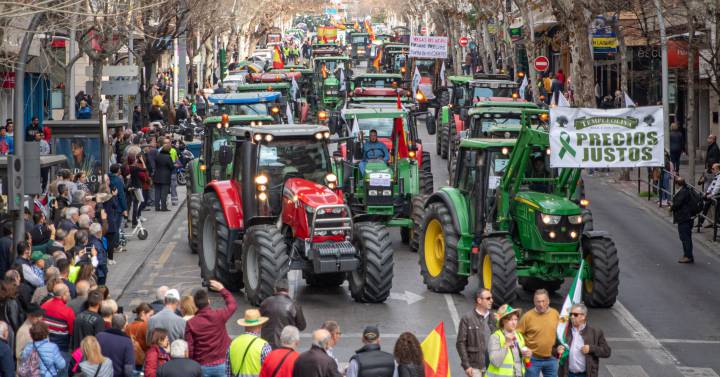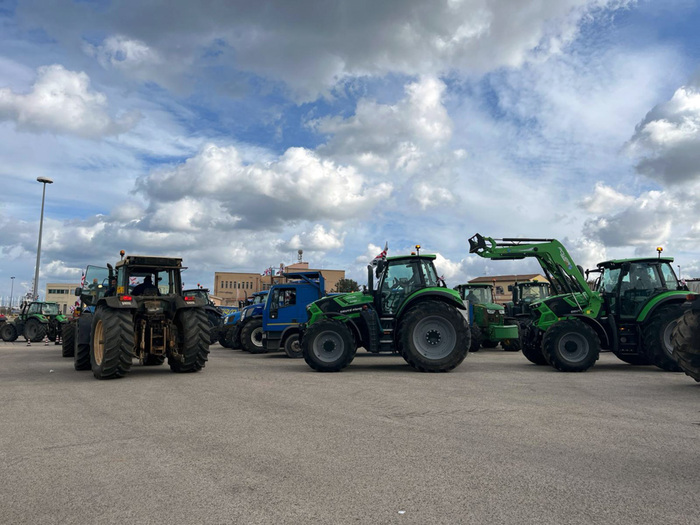The wave of protests from farmers and ranchers that started at the end of January in Galicia, Aragon and the Basque Country has filled the streets of all Spain with men and women from the countryside furious at the low prices with which their products are paid. After collapsing the Extremaduran roads on Tuesday, this movement celebrates its first three weeks with tractors built all over Granada and Pamplona that have collapsed the center of the two cities.
MORE INFORMATION
- The field intensifies its protest at the fear of cutting European aid
- Protests for low agricultural prices, in pictures
- The agrarian protest regrets with road cuts and the collapse of downtown Valencia
Before 10 in the morning, 747 tractors, according to the Government Subdelegation of Granada, were already circulating on the ring road about to enter the city. At a speed of just over 10 kilometers per hour, several columns of tractors were heading for a march that lasted about two hours. Next to them, two hundred buses arrived from all over the province, which meant more than 10,000 people accompanying the tractors. Many municipalities joined the call chartered buses or closed their facilities as a sign of support.
The call was organized by the agricultural and livestock organizations Asaja, COAG, UPA, Infaoliva, Agro-food Cooperatives of Granada and Ecohal under the slogan Fair prices for a living field . Also the local PSOE and the Popular Group in the Diputación supported the call.
In Pamplona there was a morning that, despite being February, looked like July. UAGN and UCAN, the two organizations calling for the agricultural strike on Wednesday in Navarra, chose as a protest uniform a festive outfit, white and red, usual for the San Fermines. From early in the morning columns of hundreds of tractors headed to Pamplona. From 11.30 they staged a confinement like every morning between July 7 and 14. But instead of running in front of the bulls, the participants did it in front of tractors decorated like bulls. The president of UAGN, Félix Bariáin, said that through this confinement - "the most international festival in Pamplona and Navarra" - they tried to "visualize the problems of farmers and ranchers". Bariáin saw this mobilization as "a turning point." "This does not have to stop," he warned.
The festive nature did not hide the claims of the Navarrese camp, similar to that of the rest of the sector in Spain. "To my father the calves were paid 650 pesetas a kilo and me 3.80 euros, nothing has risen in 40 years," confesses Julian, who emphasizes that the price paid by the consumer in the butcher shop is up to four times higher. Production costs are also skyrocketing compared to those of Julian's father. A tractor, remember, "then it was worth a million pesetas", now "150,000 euros, 25 times more". The future of the sector also worries about the difficulty of finding relief. "Today there are only 78 farmers under 30, when there were 78 in each town 30 years ago," said UAGN president,
Tractor confinement ended in the Plaza de las Merindades, in front of the Government Delegation in Navarra, near the usual end of Sanfermines confinement. However, the traffic in the center of Pamplona was practically collapsed from the beginning, since the tractor columns have occupied the main avenues of the city, especially the accesses from the south, the area of Navarra where the agricultural sector has more weight .
In Granada, citizens were advised since Saturday of the difficulties that the tractor unit could cause in mobility. The mobility councilor warned of a "total collapse" and "a black Wednesday" and encouraged citizens to move on foot and not take cars. In the morning, the city was in a near-emergency situation: the Mobility area had designed and made public safe access routes to hospitals.
The schools also sent a circular to families on Tuesday afternoon warning of possible traffic difficulties. They warned of possible incidents in school transport routes, both in the urban area and in the ring rounds.
The Delegation of Education of the Board recalled that it could not be guaranteed that the transport would arrive at its destination or that the return home at the end of the classes would be normal. The letter did not expressly say so, but suggested that it was not advisable to go to the school on Wednesday. The text made it clear that the absence of the student body would not be "in any case unjustified."







/cloudfront-eu-central-1.images.arcpublishing.com/prisa/TJIZLZ7VXOV4MBYNPTH2DNQ7CI.jpg)

